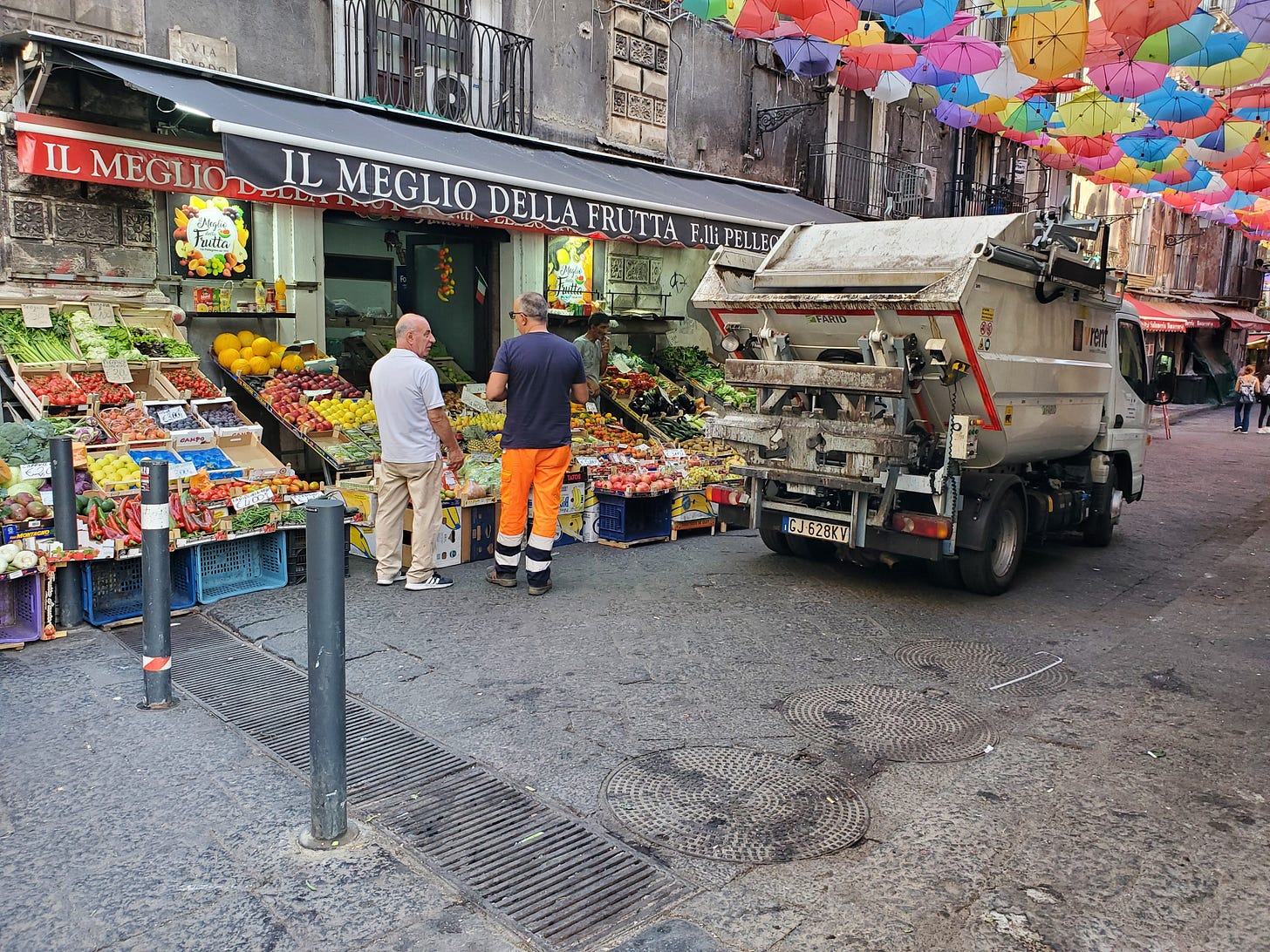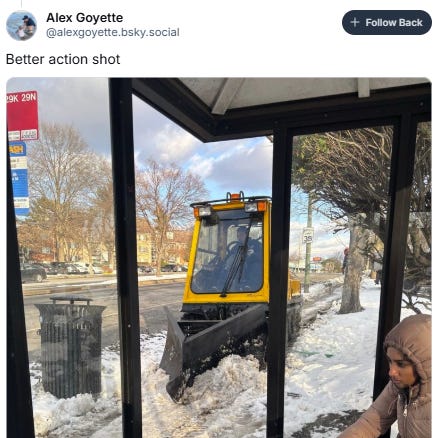I have a vehicle to show you.
But first, I want to share a couple of comments from a piece I wrote awhile ago on small trucks and urban vehicles. I’ve written about this a few times, actually: basically, how the United States doesn’t lack “real cities” as much as we lack all of the properly scaled accoutrements to complement cities.
For a concrete example of what I’m talking about, here’s a picture I took in Sicily of a baby garbage truck:
At least, “baby” is what I call it. As an American, it almost looks like a toy. You want to squeeze it and exclaim how cute it is. But none of that properly understands what it is. What it is is an urban-scaled utility vehicle.
America’s utility vehicles—firetrucks, garbage trucks, dump trucks, etc., (along with most of our consumer vehicles)—are basically suburban-scaled vehicles. We’re missing the bottom half of the “scale ladder” that corresponds to urban geometry. That’s how I think about it, anyway. I think that comes closer to capturing the reality of what we’re seeing than just complaining that cars and trucks are “too big.”
Anyway, here’s a really good comment from a reader that expresses this idea too:
When I first visited New Zealand, I was amused by the 2/3 scale of everything compared to what I was used to in Toronto. Cars and trucks, kitchen appliances, houses — everything was smaller.
Actually, my North American perspective had it all wrong — things had not yet been scaled up.
That has since been rectified. Now, in our (I’m a New Zealander now) eagerness to copy every bad idea from overseas, New Zealanders drive larger (more expensive) cars, buy larger (more expensive) appliances, and live in larger (more expensive) houses. And, like the countries we are so eager to emulate, the number of people who are homeless, the number of children who are living in poverty, and the number of renters who are spending 40%, 50%, or more of their income on housing — all are now much larger.
And another one, which touches on a whole adjacent question of markets and manufacturing:
I live in a pretty standard suburb. Wide roads, plenty of room... but our fire department is lobbying for a large “safety complex” (when combined with police) because they struggle to buy/refurbish trucks SMALL ENOUGH to fit in our main fire station, built in the 1960s.
There aren’t any huge buildings in our town that would necessitate a extra large ladder truck or other huge trucks. But American fire trucks just aren't built on that small scale anymore.
It’s a nutty but very real phenomenon that the typical sizes for utility vehicles actually determine the street widths in American development. Here’s one article about that.
Anyway, here is the vehicle I want to show you today, courtesy of Alex Goyette, housing advocate in Alexandria:
This is a sidewalk snow plow! I have never seen one of these before. Even after years of following urbanist folks online and working in this field, I have never come across this vehicle. In residential areas, responsibility for sidewalk plowing typically falls on homeowners/residents, not the city. This is on a major commercial/mixed stretch, I think, near a bus stop, so it makes sense for the city to clear it. However, in actuality, sidewalk plowing often is done poorly, late, or not at all.
While these vehicles are not common, many cities have them, or things like them. Or, as described in this news article from Rochester, New York, contractors use them on behalf of the city:
Many contractors use what Jones described as grove tractors, designed for navigating the narrow spaces between rows of trees in orchards. Per the city’s expectations, these tractors are usually fitted with V-shaped plow blades the width of a typical sidewalk.
That’s interesting. That’s a repurposing of a different kind of vehicle because, perhaps, there isn’t a large market for purpose-built sidewalk plows. However, here is a company that makes snow plow vehicles specifically for sidewalks. (Curiously, though, even here the illustrative photos are in front of buildings or in parking lots, not on actual sidewalks on urban streets.) Many of these vehicles are, or were, made by Bombardier, a Canadian company. You know who doesn’t specifically market a sidewalk plow? Caterpillar.
Despite Rochester’s sidewalk plowing program, the city still does not consider itself responsible for sidewalks:
The city’s sidewalk plowing program costs a little more than $1 million a year and is funded through a fee of about $35 on the annual property tax bill for an average home. Property owners within a downtown enhancement district – an area bounded roughly by Plymouth Avenue and Church, Chestnut and Broad Streets – pay an additional fee for enhanced sidewalk snow removal.
The city hires a fleet of private contractors who fan out after storms to plow more than 850 miles of public sidewalks. But City Code § 104-11 makes clear that property owners are ultimately responsible to keep their sidewalks free of snow and ice. The city’s website also stresses that sidewalk plowing is “supplemental.”
Here’s an article from Michigan about sidewalk plows, which the author doesn’t like:
It comes in the night, disrupts our sleep, blocks the driveway and rips the grass, and leaves in its wake what it touches at its point. I refer, of course, to the sidewalk plow.
When I was a lad in Holland, Mich., I use to thrill at the sight of the sidewalk plow, and thought it must be, along with Zamboni driver and professional baseball player, the best job in the world. I’ve grown to loathe these snow beasts, for they also symbolize how governments can disrupt the obligations, and thus the cultivation, of neighborliness.
They do not come cheaply. The city of Holland pays about $120,000 per plow and earmarks roughly $57,000 a year for the service. Under its sidewalk fund, the city of Wyoming in 2010 spent over $363,000 on snow removal. Then too, there is the problem of emissions.
The problem with “just clear the sidewalk yourself” is that often they just don’t get cleared. The idea that the city has no responsibility for clearing the sidewalks reflects the further idea that walking is merely a discretionary activity, or even a luxury, not a basic necessity. Nobody considers plowing the roads optional. The argument will kind of go, “It sure costs a lot to clear the sidewalks, and who uses them anyway?” Well, there you go.
One of the aha! moments you have as an urbanist is you go from inheriting an opinion like “Huh, isn’t it kind of unfortunate that reality and adult responsibility just entail driving everywhere?” to “Hold on, do we really have to do it this way?”
Of course we don’t. It’s chicken and egg whether the dearth of urban vehicles erodes an urban mindset, or whether the abandonment of an urban mindset reshaped the way we make vehicles and other things (both, of course, or perhaps one and then the other). But the important point is that that little snowplow isn’t “cute” or “European-style” or anything else like that. It’s just a plain old vehicle properly sized for use in an urban landscape.
Social card image credit Flickr/Simon Law, Attribution-ShareAlike 2.0 Generic
Related Reading:
Becoming What They Were By Becoming Something New
Thank you for reading! Please consider upgrading to a paid subscription to help support this newsletter. You’ll get a weekly subscribers-only piece, plus full access to the archive: over 1,200 pieces and growing. And you’ll help ensure more like this!






Our town uses a plow attachment on a Bobcat compact tractor to clear the sidewalks. Theoretically, residents are responsible for clearing the sidewalks in front of their homes - but that doesn't always happen. So the DPW usually clears the sidewalks on the main roads, especially the ones leading to the school.
Of course, people still complain about this (usually people who don't have kids who walk to school).
Regarding the fire trucks, we have two fire stations in our little town - one dating from the 1930s, and the other from the 1870s. Predictably, neither can fit the typical modern fire truck; so the fire department's trucks had to be custom made.
Along those lines, most modern living room furniture will not fit in the homes in my town. We have a lot of 18th and 19th century houses and buildings; I discovered when we first moved here that even an "apartment sized" couch wouldn't fit through the doorway of our 1860 cottage. Even in my current "modern" home (i.e., built in the 1960s), it was a bit challenging to find a living room set that was scaled to the size of the space.
I was just now at 7-eleven. Monster and Red Bull side by side. It's obvious which one is European and which one is American — and size is only the most obvious hint.